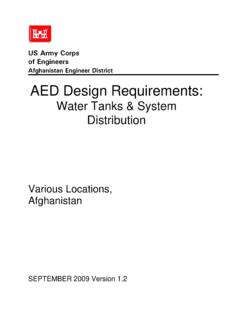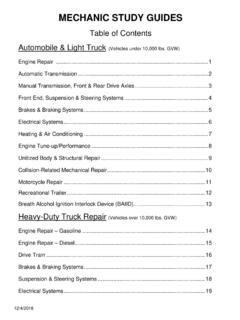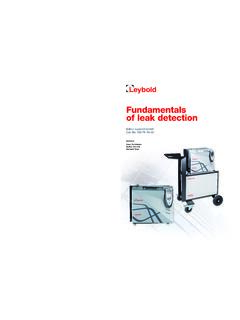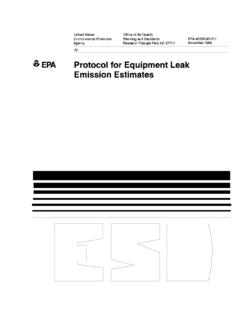Transcription of Oil/Water Separators - United States Army
1 US Army Corps of Engineers Afghanistan Engineer District AED Design Requirements: Oil/Water Separators Various Locations, Afghanistan January 2010 TABLE OF CONTENTS AED DESIGN REQUIREMENTS FOR Oil/Water Separators VARIOUS LOCATIONS, AFGHANISTAN Section Page 1. General 1 2. Oil/Water Separators 1 3. Types of Oil/Water Separators 1 4. Conventional Separators (API) 1 5. Parallel Plate Separators 2 6. Oil Collection 3 7. Design of Oil/Water Separator Systems 3 a) Wastewater Characterization 3 b) Site Considerations 4 c) Establishing the Design Flow 4 d) Pretreatment for Grit Removal 5 8.
2 Design of Oil Water Separator Systems 5 a) Parallel-Plate Separators 5 b) Conventional Separators 5 10. Design Example 6 11. Central Vehicle Wash Facilities (CVWF) 7 12. Sludge Removal and Disposal 7 13. Guidance Documents 7 14. As-Builts 7 Figures Figure 1. Conventional Gravity Separator 2 Figure 2. Downflow Parallel-Plate Separator 3 Figure 3. Oil Water Separator Layout 6 AED Design Requirements Oil/Water Separators 1 1. General The purpose of this document is to provide requirements to Contractors for any project requiring the design and construction of Oil/Water Separators .
3 2. Oil/Water Separators Oil/Water Separators are devices commonly used to separate oily waste products from wastewater streams. They are typically installed in industrial and maintenance areas such as aircraft and vehicle maintenance and washing and other activities involving petroleum, oil and lubricants (POL) to separate oils at low concentrations from wastewater. 3. Types of Oil/Water Separators There are three predominant types of Oil/Water Separators : Gravity Separators (conventional gravity Separators and parallel plate gravity Separators ) and flotation Separators . The overwhelming majority of Oil/Water Separators used are conventional gravity Separators . Gravity Separators use a process that relies on the different densities of oil, water, and solids for successful operation.
4 The wastewater is fed to a vessel sized to provide a quiescent zone of sufficient retention time to allow the oil to float to the top and the solids to settle to the bottom. Gravity oil/ water Separators come in two configurations: conventional Separators such as those designed in accordance with guidelines established by the American Petroleum Institute (API) and parallel plate Separators . The primary types of Oil/Water Separators described in this section are intended for the removal of free and emulsified oils and greases, usually as a pretreatment method before discharge to the sanitary sewer or septic system. 4. Conventional Separators (API) A typical conventional separator system is shown in Figure 1.
5 The separator itself has three chambers separated by baffles: an influent chamber, the main separator chamber, and an effluent chamber. The influent chamber removes free oil that has already separated from the Oil/Water mixture during conveyance to the unit. Two baffles separate the influent chamber from the larger, main settling chamber. The upper baffle is placed at the top of the water level and extends three quarters of the way to the bottom. It prevents the floating oil and scum from entering the main chamber, and allows it to be skimmed off through an overflow pipe. The lower baffle extends from the bottom and directs the wastewater to the top of the main chamber and to prevent short-circuiting.
6 In the main separator chamber, the oily wastewater flows from one end to the other under quiescent conditions. The wastewater velocity is kept very low, typically less than m/min to prevent turbulent mixing. For flat-bottom chambers, removal of settled solids is typically accomplished by taking the chamber out of service; the chamber is drained and accumulated solids are removed either manually or by a vacuum truck. If the floor is sloped, the solids can be removed from the hopper or V-bottom trough by pumping or gravity discharge while the unit is still in service. An oil-skimming device should be provided at the end of the separation chamber. The rotatable, slotted-pipe skimmer is the most common type.
7 Other oil-skimming devices include belt skimmers and floating skimmers. The oil collected by the skimmer is discharged to a used oil holding tank. The effluent chamber is also separated from the main chamber by upper and lower baffles. Wastewater flows under and over the baffles into the effluent chamber. From the effluent chamber, the treated water can be discharged to the sewer system or to additional treatment if necessary. AED Design Requirements Oil/Water Separators 2 Figure 1. Conventional Gravity Separator 5. Parallel Plate Separators A typical parallel-plate separator system is shown in Figure 2. Parallel-plate Separators function on the same principles as conventional gravity Separators , but they require less space.
8 Incorporating an array of closely spaced parallel plates within the separator chamber increases the surface settling area, allowing the overall size of the unit to be reduced. Flow through a parallel-plate unit can be two to three times that of an equivalently sized conventional separator. The oil is removed by passing the wastewater at laminar velocity through the pack of closely spaced plates, which are constructed at various inclines ranging from 45 to 60 degrees. The oil droplets rise vertically until they contact the underside of the plates, where the oil coalesces and continues to gradually move upward along the underside of the inclined plates. Eventually, the floating oil is collected at the surface of the tank.
9 The plates aid in separation in the following ways: Prevent shout-circuiting of the oily waste. Increase the effective settling area. Enhance contact/agglomeration of oil particles. The plates may be made of an oleophilic (oil attracting) material, such as polyethylene, fiberglass, or nylon to promote coalescence of oil droplets. For this reason, the units are sometimes referred to as coalescing plate Separators . Parallel or coalescing plate Separators are usually recommended only for light oil loadings when a higher level of oil removal is required, when the wastewater stream contains minimal solids concentrations, and when the facility is committed to the additional maintenance procedures required keeping the coalescing pack free of debris.
10 The plates may also be constructed in a corrugated configuration with alternate troughs and ridges, such as in the Corrugated Plate Interceptor (CPI). It should be noted that polypropylene is not recommended for AED Design Requirements Oil/Water Separators 3 use in coalescing plates because it has been found to have excessively strong oleophilic properties that prevent oil droplets from detaching and floating to the surface. In parallel-plate Separators , solids settle to the bottom and are collected in a sludge well. From the well, sludge is pumped or withdrawn by gravity. If sludge transfer is by gravity displacement, an automatic valve is usually provided. Figure 2. Downflow Parallel-Plate Separator 6.





